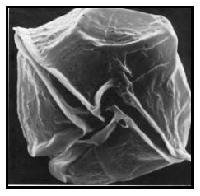|

Enlarge image |
Alexandrium fundyense, ca. 40 microns in diameter
| 
Enlarge image |
SST image courtesy of Andrew Thomas, University of Maine
|
Harmful Algal Blooms
Harmful algal blooms (HABs) occur in many regions of the global coastal ocean. The culprit organisms are taxonomically diverse, and produce a wide variety of deleterious effects ranging from ecosystem disturbance to serious threats to human health. The very nature of HABs necessitates a species-based approach, thereby providing a valuable context for study of the physical-biological interactions controlling planktonic algal blooms. The societal impact of these problems makes for an appealing synergy between basic and applied research.
One of the major challenges to understanding the underlying controls on HABs stems from the oceanographic context in which these phenomena take place. In some cases, HABs are initiated and develop offshore and it is not until they impinge upon the coast that their most significant consequences are felt. This appears to be the case with blooms of the toxic dinoflagellate Alexandrium, the organism responsible for Paralytic Shellfish Poisoning (PSP) in the Gulf of Maine. Alexandrium has a complex life cycle, in which it can lie dormant as a resting cyst in the sediments for years. Once germinated from the sediments, the cells swim toward the surface to begin a phase of vegetative growth. When faced with environmental stress such as nutrient limitation, the vegetative cells form gametes that subsequently fuse into a zygote. The zygote then encysts and the cycle is complete. This intricate life history strategy has important ramifications with respect to both the timing of seasonal blooms and long-term persistence of the organism in specific geographic areas.
The spatial distribution of benthic cysts may therefore be a key factor in initiating Alexandrium blooms. Although previous investigations have provided information on cyst abundance in some areas of the Gulf of Maine, the regional-scale distribution remained obscure until the first systematic survey was undertaken in 1997 as part of the ECOHAB-GOM program led by Don Anderson. The cyst map reveals that highest abundances of Alexandrium cysts are located well offshore. This result is noteworthy in light of the fact that blooms of vegetative cells in the Western Gulf of Maine are observed in coastally-trapped river plumes, as described in prior work by Franks and Anderson. How might offshore cysts contribute to inshore blooms of Alexandrium in the Western Gulf of Maine? We investigated this question with a coupled three-dimensional physical-biological model, and the results suggest a simple mechanism by which cells germinated from offshore cysts can become entrained into a buoyant coastal current (McGillicuddy et al., 2003 ). The mechanism arises from the joint effects of organism behavior and the wind-driven response of a surface-trapped plume of fresh water originating from riverine sources. During upwelling-favorable winds, the plume thins vertically and extends offshore; downwelling winds thicken the plume and confine it to the nearshore region. In the western Gulf of Maine, the offshore extent of the river plume during upwelling conditions is sufficient to entrain upward-swimming Alexandrium cells germinated from offshore cyst beds. Subsequent downwelling conditions then transport those populations toward the coast. The implications of this mechanism for cross-shore flux of organisms are substantial, in that the processes linking coastal and offshore environments are subtle, complex, and non-linear. Our ability to understand and eventually predict HABs and other coupled physical-biological phenomena in the coastal ocean depends critically on elucidation of these linkages.
Related links
ECOHAB-GOM
A Mechanism for offshore initiation of harmful algal blooms in the coastal Gulf of Maine Alexandrium Bloom Transport: Observations and Models COHH |
|
